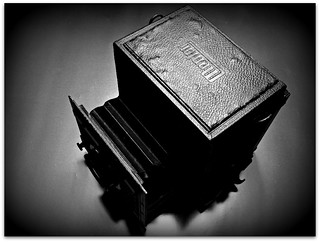Mentor Reflex

|
| image by Vagn Sloth-Madsen (Image rights) |
The Mentor Reflex is a box-form single lens reflex camera made by Goltz & Breutmann. Their first SLR was simply called the Spiegel-Reflex-Kamera, and made in about 1898[1], but is the precursor of the Mentor Reflex of 1905 onward. The camera was redesigned several times: McKeown lists versions of 1905, 1907, 1911, 1914 and 1926.[1][2] All of these are wooden-bodied, box-form SLR cameras, with the lens-board mounted at the front of a bellows with rack-and-pinion focusing. The board allows front rise. The camera has a ground-glass focusing screen at the top of the body, with a folding leather hood. A ground-glass screen can also be fitted at the back, using the camera as a view camera. The camera has a focal plane shutter,[3] with speeds (in some models) up to 1/1300 second. McKeown states that in cameras before about 1934, the shutter speed is adjusted by setting a slit-width and spring tension (with the aid of a table fastened to the camera); after this, the exposure times themselves are marked on the dial.[1][4]
The name is also applied to the Mentor Studio Reflex[5], a strictly a different model, with more front camera-movements[6], made from 1927 until the 1950s (and again redesigned more than once), and may perhaps also refer to the Mentor Folding Reflex (Klapp-Reflex)[7] with a more compact, collapsing body, and Mentor Sport-Reflex (with a wire-frame finder and helical (not bellows) focusing, for speed of use). Stereo models were made,[8] and some of the cameras were available in tropical materials (to better resist humidity and insect attack).[9]
The Mentor Reflex was available for several plate sizes (and later, sizes of cut film): 6x9, 6.5x9, 9x9, 9x12, 10x15 and 13x18 cm.
Many different lenses were supplied with the cameras over the long period they were made. Most early cameras have double anastigmats, including lenses by Meyer and Goerz. Later cameras often have Tessars.
Notes
- ↑ 1.0 1.1 1.2 McKeown, James M. and Joan C. McKeown's Price Guide to Antique and Classic Cameras, 12th Edition, 2005-2006. USA, Centennial Photo Service, 2004. ISBN 0-931838-40-1 (hardcover). ISBN 0-931838-41-X (softcover)., p659.
- ↑ 9x12 Mentor Reflex, 1914 model, with 18 cm f/4.5 Tessar and rotating back, sold at the twelfth Westlicht Photographica Auction, in November 2007.
- ↑ German Patent 399929 Schlitzverschluß (filed 1923 and granted 1924) and German Patent 446097, Schlitzverschluß mit gedecktem Aufzug der Vorhänge (filed 1925 and granted 1927), describing a self-capping slit-shutter, and a design improvement to it, at Espacenet, the patent search facility of the European Patent Office.
- ↑ 9x12 cm Mentor Reflex (probably the 1914 model; the lens, an 18 cm f/4.5 Tessar, is dated to 1915) at Early Photography; notes describe the shutter speed settings.
- ↑ 9x12 cm Mentor Studio Reflex, 1934 model, with 210 mm f/3.5 Meyer Trioplan and shutter to 1/600 second, sold at the fifteenth Westlicht auction, in May 2009.
- ↑ German Patent 460784, filed in 1928 and granted 1928, Horizontal und vertikal neigbarer Objektivträger für photographische Reflex-Kameras (Lens panel with swing and tilt for reflex cameras); at Espacenet.
- ↑ 6.5x9 cm Mentor Klapp-Reflex with 12 cm f/2.7 Tessar (this lens required a special, deeper camera body than the standard f/4.5 Tessar), also sold at the May 2009 Westlicht auction.
- ↑ 6x13 cm Mentor Stereo Reflex, about 1920, with 9 cm f/4,5 Tessar lenses, sold at the second/third Westlicht auction in May 2003.
- ↑ 6.5x9 cm Mentor Tropical Reflex, dated by the auctioneer to about 1918, with 18 cm f/4.5 Tessar, sold at the first Westlicht auction, in November 2002.